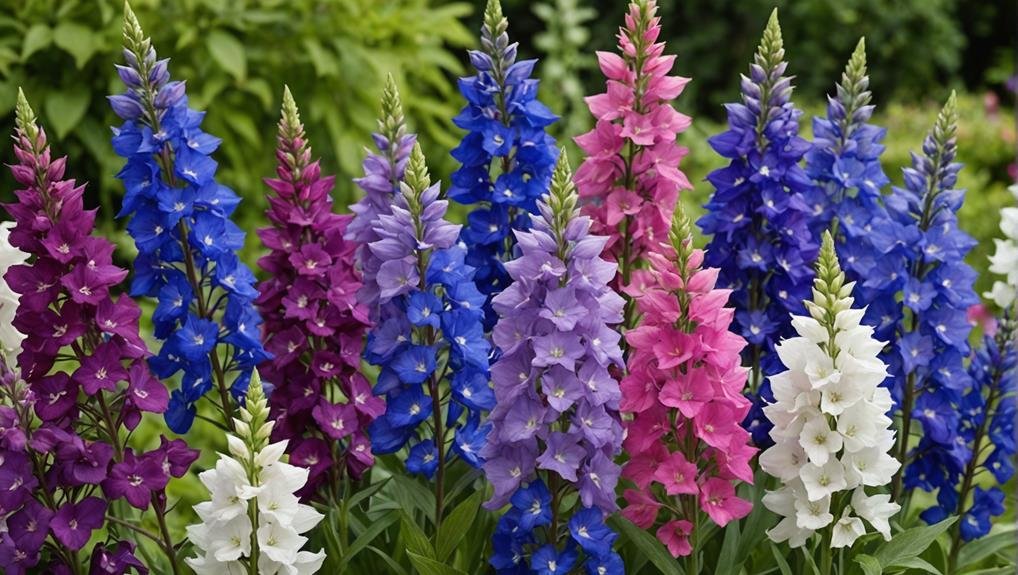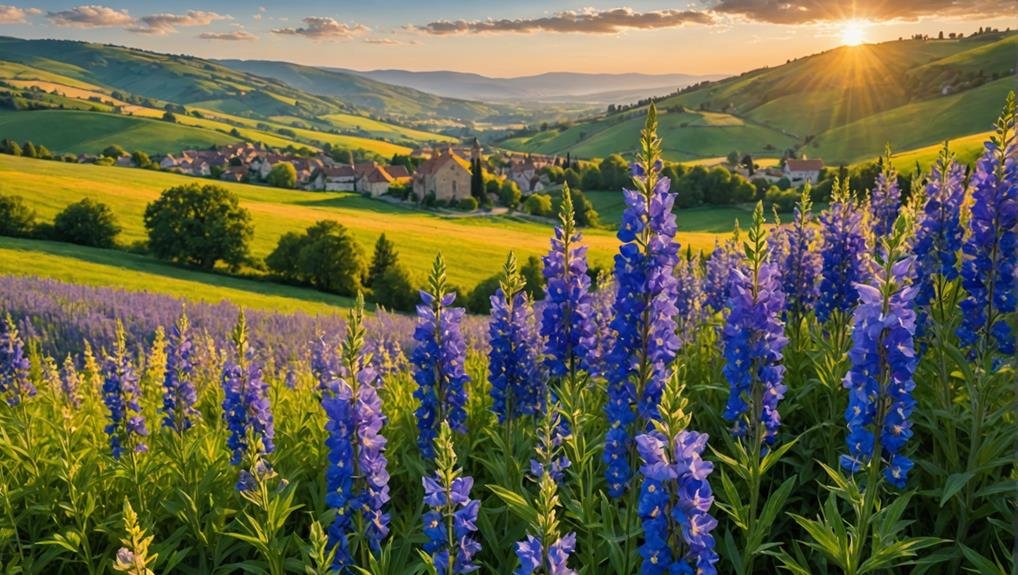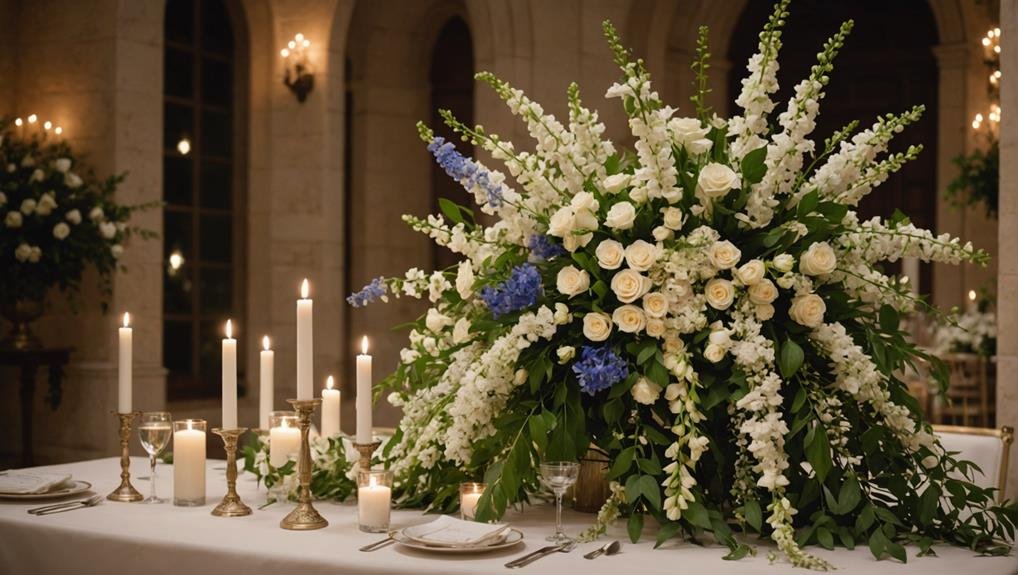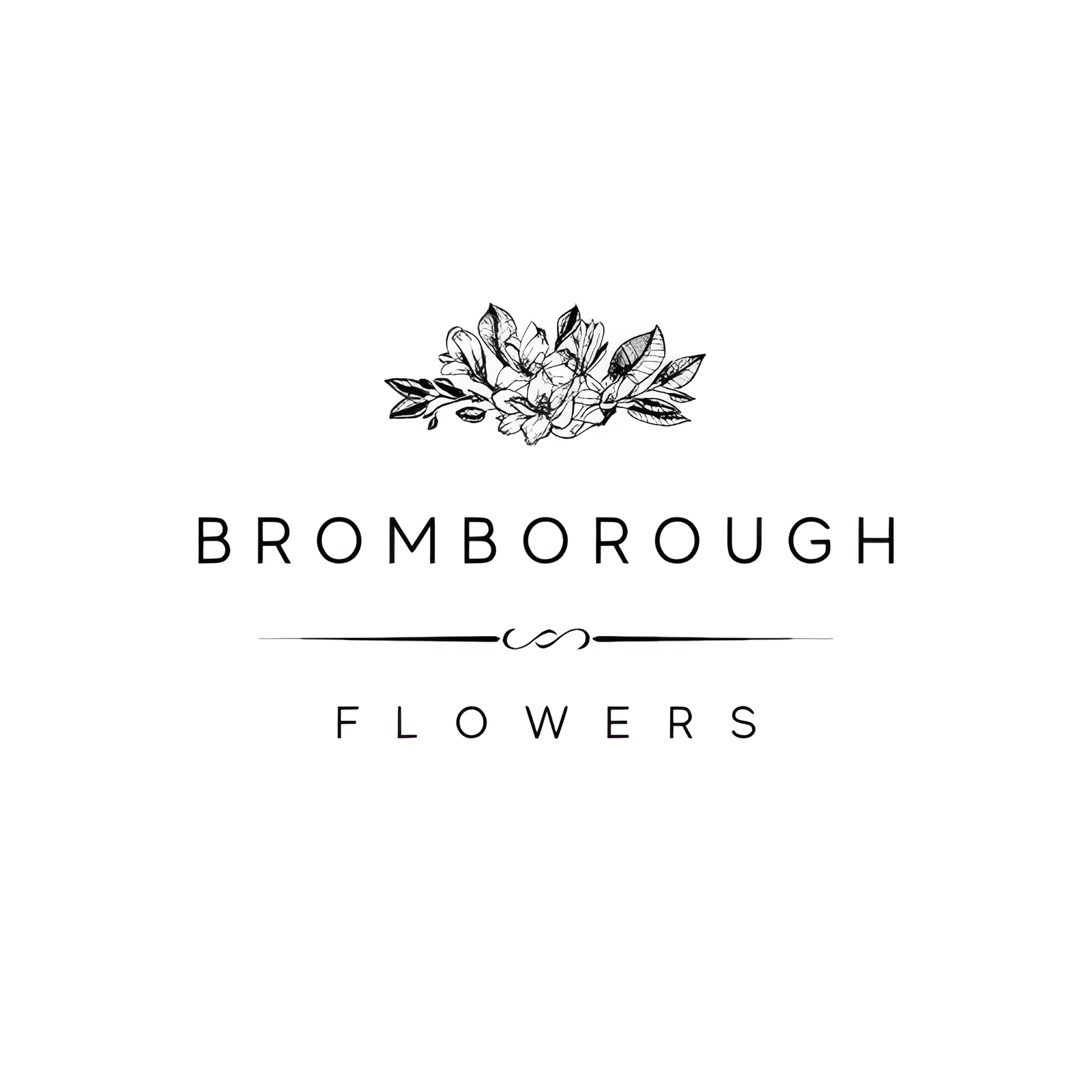Larkspur, a distinguished member of the buttercup family, offers an exquisite blend of elegance and symbolism, making it an ideal addition to wedding floral arrangements. Characterized by its delicate, ruffled petals and slender, towering stalks, larkspur comes in a variety of colors such as lavender, purple, white, and pink, ensuring versatility for any wedding theme. Its availability from early spring to late summer aligns perfectly with warm-weather nuptials. Additionally, its rich cultural significance can add a layer of depth and meaning to the celebration. But what makes larkspur truly unique in wedding decor?
Flower Overview

Larkspur, renowned for its tall, spiky blooms and diverse color palette, is a favored choice for wedding flowers due to its symbolic representation of first love, affection, and happiness. These flowers, which belong to the buttercup family, have become a staple in wedding floral arrangements because of their elegant and versatile nature.
Larkspur blooms from early spring to late summer, making them particularly suitable for warm-weather weddings. This seasonal availability guarantees that couples can enjoy the vibrant and striking presence of larkspur during their special day.
The wide range of colors available, from soft pastels to vivid blues, purples, and pinks, allows larkspur to complement various wedding themes and color schemes. This flexibility makes it an excellent choice for brides and grooms looking to create personalized and memorable floral displays.
Additionally, the tall blooms of larkspur add height and visual interest to bouquets and centerpieces, making them a focal point in any arrangement.
Incorporating larkspur into wedding decor not only enhances the aesthetic appeal but also infuses the event with the profound meaning of first love, affection, and happiness, qualities that are cherished in any marital celebration.
Physical Description
Characterized by ruffly petals adorning slender stalks, the physical form of larkspur exudes a sweet and wildflower charm. These delicate blooms stand tall and elegant, often reaching heights of up to four feet, and are renowned for their vertical growth and light, feathery appearance. The ruffled petals create a soft, romantic touch, making larkspur flowers a popular choice for adding an airy and angelic nature to floral arrangements.
Larkspur flowers serve as ideal filler flowers, enhancing the overall structure and depth of bouquets and centerpieces. Their sweet and wildflower look seamlessly integrates into rustic designs, lending a whimsical feel to wedding decor and other special events. The slender stalks, adorned with multiple blooms, offer a sporadic and natural element that complements more structured flowers, balancing the arrangement with their effortless beauty.
| Feature | Description |
|---|---|
| Petals | Ruffly and delicate |
| Stalks | Slender and tall |
| Look | Sweet, wildflower, romantic |
| Arrangement Role | Filler flowers |
| Design Compatibility | Rustic, whimsical, airy, angelic |
| Event Suitability | Weddings, baby showers, DIY creations |
The versatile nature of larkspur flowers makes them an excellent addition to various floral designs, ensuring a charming and enchanting presentation.
Available Colour Varieties

A stunning array of color varieties, including lavender, purple, white, and pink, gives larkspur flowers their versatility in wedding arrangements. These diverse color options make larkspur an excellent choice for couples seeking to create vibrant and eye-catching floral displays on their special day. The versatility of these blooms allows them to seamlessly blend into various wedding themes and color palettes.
The different hues of larkspur each carry unique symbolic meanings, enhancing their appeal in wedding settings. For instance, the soft, pastel tones of lavender larkspur evoke sentiments of first love and devotion, while the deep, rich shades of purple larkspur symbolize affection and admiration. White larkspur adds an elegant and classic touch, often associated with purity and new beginnings, whereas pink larkspur exudes happiness and romance.
To paint a vivid picture of the possibilities, consider incorporating larkspur in the following ways:
- Bridal bouquets: Combining white and pink larkspur for a timeless, romantic look.
- Centerpieces: Using purple larkspur to create dramatic, eye-catching focal points.
- Ceremony arches: Weaving lavender larkspur into the arch for a delicate, whimsical effect.
The colorful and versatile nature of larkspur flowers guarantees they remain a popular and cherished choice for wedding arrangements.
Latin Name and Taxonomy
Known in the scientific community as Consolida, larkspur belongs to the buttercup family, Ranunculaceae. This classification places larkspur within a broader group of flowering plants known for their vibrant and varied blooms.
The taxonomy of larkspur further categorizes it in the Delphinium genus, highlighting its close relationship to delphinium flowers, which are equally adored for their ornamental qualities.
Larkspur is distinguished by its tall, spiky blooms, making it a favored choice for wedding bouquets and other floral arrangements. These spiky blooms not only add height and texture to floral designs but also come in an impressive array of colors, including blue, purple, pink, and white. This diversity allows for versatile applications in various wedding themes and color palettes.
Understanding the taxonomy of larkspur is essential for floral designers and enthusiasts, as it underscores the plant's versatility and aesthetic appeal. With over 300 varieties available, larkspur's classification within the Delphinium genus provides a rich selection for creating striking and personalized floral designs.
Whether used as a focal point or as complementary blooms, larkspur's connection to the buttercup family, Ranunculaceae, and its varied colors make it an exceptional choice for any wedding bouquet or arrangement.
Geographical Origins

Larkspur flowers originate from diverse regions, including Asia, Europe, and the Mediterranean. These striking flowers have a rich history that traces back to various parts of the world, where they have long been admired for their vibrant colors and tall, elegant spikes. Their geographical origins span across continents, contributing to their widespread appeal and adaptability in different climates.
In the mid-1500s, Larkspur flowers were introduced to Britain, where they quickly became a common garden feature. Their ability to thrive in warm climates and well-drained soil made them an ideal choice for gardeners seeking resilient and visually appealing plants.
The natural habitats of Larkspur flowers include:
- Fields
- Meadows
- Open grasslands
These environments provide the necessary conditions for Larkspur flowers to flourish, with plenty of sunlight and moderate temperatures playing an important role in their development. The Mediterranean region, in particular, offers an ideal setting with its warm, sunny climate and well-drained soil.
Over time, these flowers have adapted to various regions, making them a versatile and beloved choice for both wild landscapes and cultivated gardens. Their enduring popularity highlights their significance and timeless beauty in the world of horticulture.
Season Availability
Their extensive geographical origins contribute to the widespread seasonal availability of larkspur flowers, which bloom from early spring to late summer and can be sourced year-round. This makes larkspur flowers an excellent choice for warm-weather weddings, guaranteeing that they are accessible and abundant during the peak wedding season. The blooming period of larkspur is particularly prolific, providing a steady supply for wedding arrangements during these months.
One of the key advantages of larkspur is its year-round availability. This means that even outside the primary blooming season, larkspur can be incorporated into wedding floral designs without any issues. This flexibility allows couples and florists to plan wedding bouquets and decorations with confidence, knowing that larkspur flowers will be available regardless of the time of year.
Additionally, the vase life of larkspur flowers, which ranges from 5 to 7 days, guarantees that wedding displays maintain their vibrancy and elegance throughout the event. Their seasonal availability, coupled with their beautiful range of colors, makes larkspur a popular choice for adding both color and elegance to various wedding arrangements. This consistency and reliability make larkspur flowers a staple in the floral industry, particularly for weddings.
Growing Conditions

Ideal growing conditions for larkspur include full sun to partial shade, well-drained soil, and good air circulation. These factors are essential for ensuring the healthy growth and vibrant blooms of larkspur, making them a popular choice for wedding arrangements. Larkspur thrives in cooler temperatures and can even tolerate light frosts, which makes them particularly well-suited for spring and early summer weddings.
To paint a clearer picture, consider the following essentials for cultivating larkspur:
- Sunlight Exposure: Larkspur requires full sun to partial shade to flourish.
- Soil Requirements: Well-drained soil is crucial to prevent waterlogging and root rot.
- Watering Needs: Regular watering is vital, but overwatering should be avoided.
In addition to these conditions, maintaining good air circulation around the plants helps deter fungal diseases. Larkspur plants can reach impressive heights of up to 4 feet, adding both height and an elegant touch to any floral arrangement.
Regular watering is essential, yet it is important to strike a balance, as excessive moisture can lead to root rot. By adhering to these growing conditions, larkspur can be a cost-effective and stunning choice for wedding flowers, bringing both beauty and sophistication to the event.
Cultural Significance
Renowned for its symbolic meanings, the larkspur flower embodies lightness, humor, and sincerity in the language of flowers. This cultural significance is deeply rooted in various historical contexts, making the larkspur a cherished choice for different occasions.
During the Victorian era, the larkspur was a popular gift, believed to ward off evil and bring about a positive atmosphere. Its delicate, claw-like blooms, reminiscent of a lark bird, were often exchanged to express sentiments of cheerfulness and goodwill. The flower's symbolism of lightness and humor made it a delightful addition to Victorian floral arrangements.
Moreover, the larkspur holds a special place in Native American traditions. The petals of this vibrant flower were used to create blue dye, showcasing its practical and cultural importance. This aspect highlights the flower's multifaceted role in different societies.
As the July birth flower, along with water lilies, the larkspur is celebrated for its association with summer's peak. Its presence in gardens and bouquets during this month symbolizes sincerity and the joy of life.
Typical Use in Weddings

Larkspur's delicate and airy appearance makes it a popular choice for adding a romantic touch to wedding bouquets and arrangements. Its tall, spiky blooms create stunning centerpieces and focal points in wedding decor, infusing a sense of elegance and charm. These flowers symbolize first love, affection, and happiness, making them a meaningful choice for wedding ceremonies.
Larkspur is available in a variety of colors, including lavender, purple, white, and pink, allowing it to easily complement different wedding color schemes. Its versatility enables it to blend seamlessly with other flowers or stand out as a striking solo element. The warm-weather blooms are ideal for weddings from early spring to late summer, offering a fresh and vibrant look.
- Bouquets: Larkspur adds height and texture to bridal and bridesmaid bouquets, creating a romantic and airy feel.
- Centerpieces: Tall and spiky larkspur stems make dramatic and eye-catching centerpieces for reception tables.
- Arrangements: These flowers are perfect for larger floral arrangements, adorning wedding arches, aisle decorations, and entrance displays.
Incorporating larkspur into wedding florals not only enhances the aesthetic but also imbues the event with the symbolism of first love and happiness.
Alternative Flower Types
When considering alternatives to larkspur for wedding floral arrangements, several other flower types offer similar aesthetic qualities and symbolic meanings.
Delphiniums, for instance, provide a tall and striking appearance that closely resembles larkspur. They come in a range of shades, making them a versatile choice for various color schemes.
Snapdragons are another excellent option, known for their versatility and wide array of colors. These flowers can easily be incorporated into bouquets and centerpieces, adding both height and visual interest.
Gladiolus also serves as a striking substitute, adding vertical interest and a bold statement to any wedding flower design.
Stock flowers are a wonderful alternative, offering the added benefit of being fragrant. Their spiky blooms are reminiscent of larkspur, making them suitable for wedding décor.
Sweet peas, on the other hand, provide a more delicate and romantic option. These flowers are perfect for adding a touch of elegance to bridal bouquets and boutonnieres, enhancing the overall romantic atmosphere of the event.
Incorporating these alternatives can help achieve the desired aesthetic while offering additional benefits such as fragrance and versatility. Whether opting for delphiniums, snapdragons, gladiolus, stock flowers, or sweet peas, each choice brings its unique charm to a wedding celebration.
